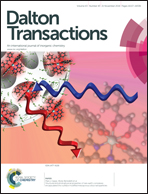The ionothermal synthesis, structure, and magnetism–structure relationship of two biphenyl tetracarboxylic acid-based metal–organic frameworks†
Abstract
Two new metal–organic frameworks (1–2) were ionothermally obtained by the reaction of a biphenyltetracarboxylic sodium (Na4BPTC) ligand and M(OOCCH3)2 (M = Co(1) and Mn(2)). Crystal structure analysis reveals that 1 is a Co3Na6 unit-based three dimensional heterometallic MOF, while 2 exhibits a {Mn(COO)n} chain-based three-dimensional framework. Furthermore, the magnetic measurement shows that both of them have anti-ferromagnetic properties. A combination of Density Functional Theory (DFT) and Quantum Monte Carlo (QMC) simulation uncovers that in 2 the coupling parameters between two adjacent Mn(II) ions are J1 = −2.0 cm−1 and J2 = −1.6 cm−1, and the magnetism mainly originates from the propagation of Mn(II) ions by the super-exchange of carboxylates. Interestingly, the superexchange modes of J1 and J2 are different. Two spin nets of −/+/− dominate in the coupling for J1, while for J2 there are two spin nets of −/+/− and one spin net of +/−/+.


 Please wait while we load your content...
Please wait while we load your content...